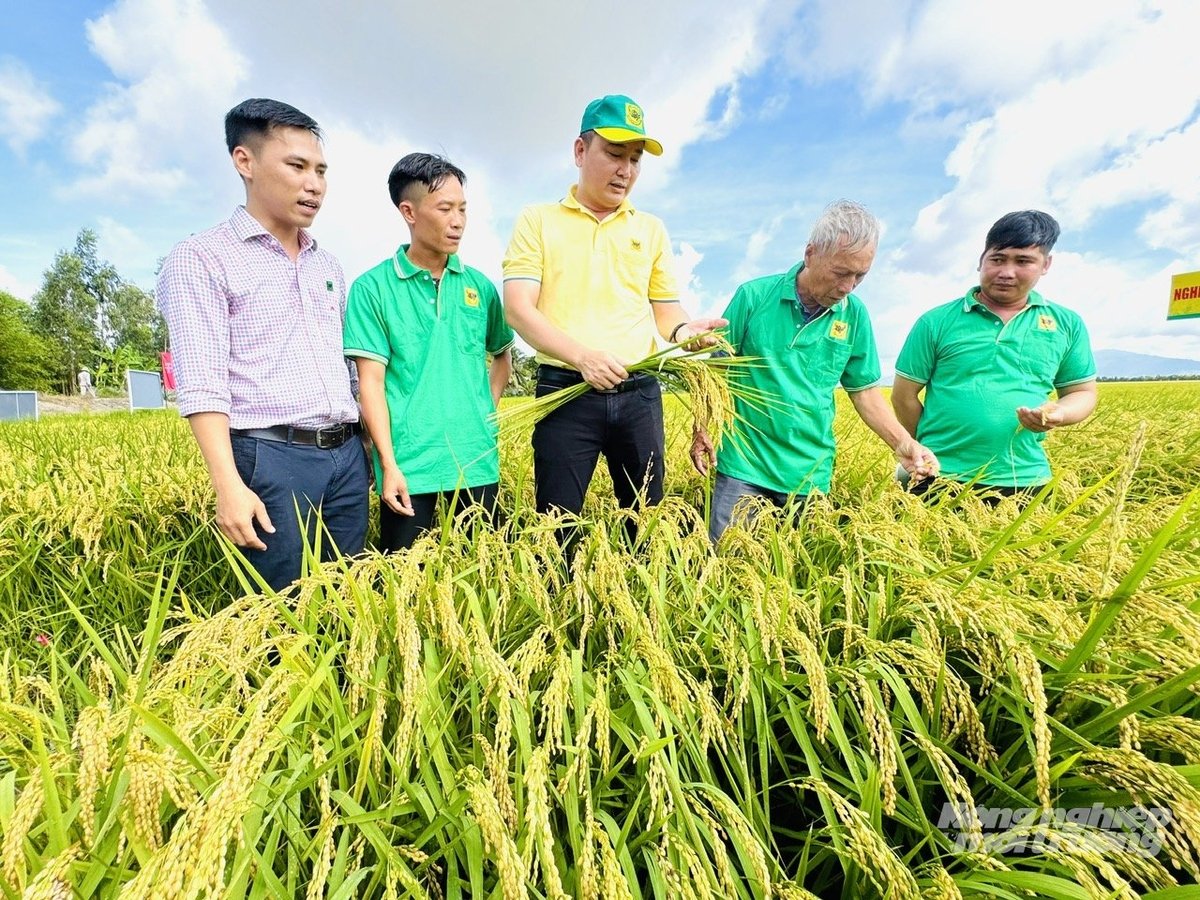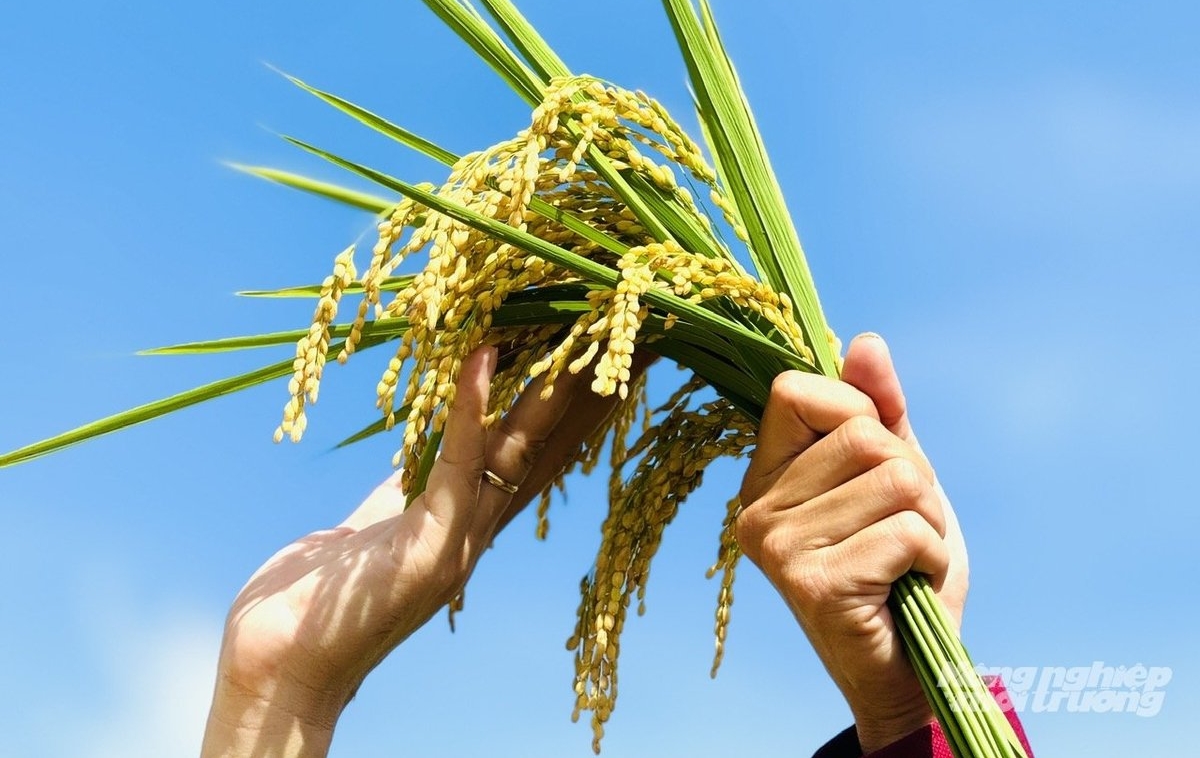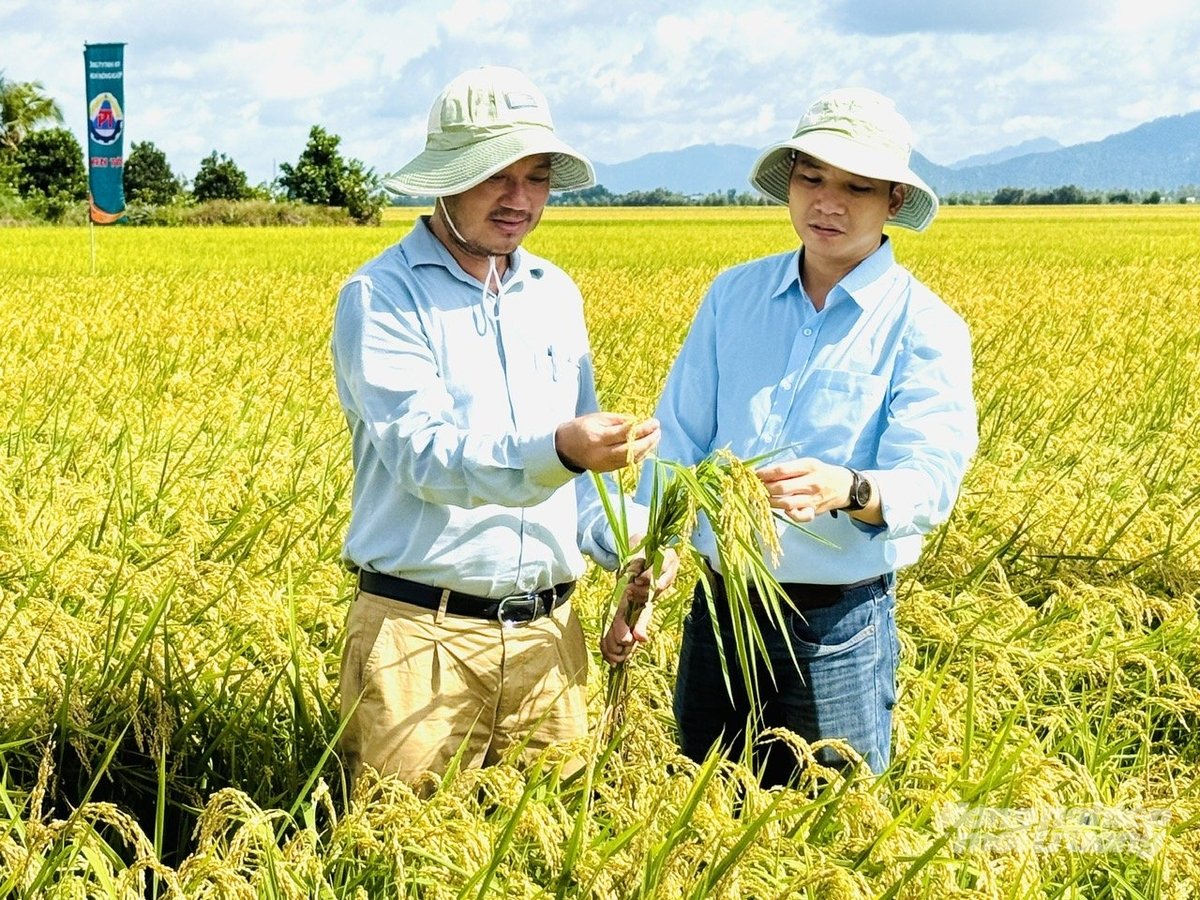December 30, 2025 | 21:56 GMT +7
December 30, 2025 | 21:56 GMT +7
Hotline: 0913.378.918
December 30, 2025 | 21:56 GMT +7
Hotline: 0913.378.918
On August 22 in Hon Dat commune, An Giang province, the An Giang Provincial Agricultural Extension Center held a workshop to review the central agricultural extension project "Developing a low-emission rice cultivation model for sustainable development of the Mekong Delta’s rice export production zones" during the 2025 summer-autumn crop.
The workshop attracted representatives of several agricultural cooperatives as well as more than 150 farmers both within and outside the model, who came to observe and exchange experiences.

The high-quality, low-emission rice cultivation model at Vinacam Hon Dat Agricultural Cooperative, An Giang province, helps reduce costs, increase profits, and cut greenhouse gas emissions by 37%. Photo: Le Hoang Vu.
This program, led by Binh Dien Fertilizer Joint Stock Company, is being implemented in key rice-producing provinces including An Giang, Can Tho, and Dong Thap. At Vinacam Hon Dat Agricultural Cooperative (Son An hamlet, Hon Dat commune), the 50-hectare high-quality rice model has recorded many positive results, confirming the effectiveness of low-emission farming practices.
According to Mr. Le Van Dung, Deputy Director of the An Giang Provincial Agricultural Extension Center, the model follows high-quality and low-emission rice production processes aligned with the Government’s Project of One Million Hectares of High-quality Rice. The model's standout feature is its ability to reduce production costs, increase yields, and establish stable production and marketing linkages between farmers, cooperatives, and export enterprises.
According to the summary report, production costs under the model were about 27.1 million VND/ha, which is 1.52 million VND/ha lower than non-model fields. By reducing seeding rates, using balanced fertilization combined with organic fertilizers, and applying integrated pest management (IPM), farmers saved on seeds, fertilizers, and pesticides.
The average yield within the model reached 9.24 tons/ha, 0.28 tons/ha higher than non-model fields. Rice prices were also 300 VND/kg higher than the market rate, thanks to meeting strict quality standards and residue control. As a result, average profit under the model reached over 37.5 million VND/ha, 6.1 million VND/ha higher than outside the model, with a profit margin of 138%-29% higher than conventional production.
Mr. Danh Sương, Director of Vinacam Hon Dat Agricultural Cooperative, shared: "By joining the model, farmers clearly see the benefits: lower costs and better rice prices. More importantly, the cooperative has built stable linkages with export enterprises, ensuring sustainable market access and encouraging farmers to continue expanding the model."

At Vinacam Hon Dat Agricultural Cooperative, low-emission rice farming has helped farmers earn an additional profit of 6 million VND per hectare. Photo: Le Hoang Vu.
Alongside its economic benefits, the model has delivered remarkable results in reducing greenhouse gas emissions. The application of clustered seeding techniques, alternate wetting and drying (AWD) water management, combined with straw collection and the use of microbial products, has significantly lowered emissions from rice cultivation activities.
Measurements and calculations based on the IPCC (2019) methodology show that the model achieved an average reduction of 12.32 tons of CO2 equivalent per hectare compared with baseline emissions, equivalent to a 37.22% decrease. Compared with control fields, the reduction reached 1.68 tons of CO2 equivalent per hectare. This provides clear evidence of the model’s potential to contribute to the agricultural sector’s greenhouse gas reduction commitments.
Mr. Ho The Huy, Deputy Marketing Director of Binh Dien Fertilizer Joint Stock Company and Project Manager, noted that the model in Hon Dat commune (An Giang), despite being located on acid sulfate soils with challenging farming conditions, has far exceeded expectations after two cropping seasons. Average yields reached over 7 tons per hectare, much higher than the initial target of 6.2 tons per hectare.
According to Mr. Huy, the project not only improved yields but also effectively implemented greening solutions from the factory to the field. Among these, the smart rice farming approach stood out, helping reduce production costs, lower nitrogen fertilizer use, and reduce spraying frequency while enabling farmers to better manage water. Collectively, these practices have contributed to emission reductions compared with the Mekong Delta’s regional average.

The low-emission rice cultivation model at Vinacam Hon Dat Agricultural Cooperative has been implemented with a comprehensive application of advanced farming techniques. Photo: Le Hoang Vu.
In addition, Binh Dien has been testing a line of NPK fertilizers enriched with beneficial microorganisms to decompose rice straw in the field. Initial results show that the soil has improved significantly, with pH levels rising from 4.2 to 5-5.5, and essential nutrients such as calcium, magnesium, and potassium becoming more readily available. This is a positive signal, helping farmers not only cultivate more effectively but also move toward sustainable, low-emission agriculture.
As a partner in the Central Agricultural Extension Project in the Mekong Delta, Mr. Nguyen Truong Vuong, Director of External Affairs, Crop Science Division, Bayer Vietnam, shared: building on the success and positive outcomes of the model in Hon Dat commune, An Giang province, as well as from public–private partnership programs, the Bayer ForwardFarming model is now being introduced to farmers and cooperatives to promote smart, low-emission rice farming. For nearly three years, Bayer has also been actively implementing models under the Government’s one-million-hectare high-quality, low-emission rice initiative.
Bayer is committed to continuing its support, expansion, and development of these models in the coming years to support the agricultural sector effectively. Alongside model development, Bayer also provides training, capacity building, and technology transfer in sustainable rice cultivation. This will contribute to the growth of high-quality, low-emission rice production zones for export in the Mekong Delta in the near future.

Bayer is committed to continuing its support, expansion, and development of smart, low-emission rice farming models in the coming years. Photo: Le Hoang Vu.
According to the An Giang Provincial Agricultural Extension Center, the model implemented at Vinacam Hon Dat Agricultural Cooperative has applied a comprehensive set of solutions: full mechanization of sowing, crop care, and harvesting across 100% of the cultivated area; reducing seeding density from 100 kg/ha to 70 kg/ha; increasing the use of organic fertilizers; and adopting integrated pest management as well as efficient water management practices.
Beyond delivering economic and environmental benefits, the model also lays the foundation for developing high-quality rice production zones that meet export standards for demanding markets such as the EU, the U.S., and Japan. At the same time, through training sessions, field visits, and on-site workshops, farmers have gained knowledge and become more proactive in applying technical innovations in their fields.
"The workshop reached a consensus to recommend scaling up this model across the province as well as in other key production areas, while at the same time encouraging cooperatives and farmers to maintain production and marketing linkages with enterprises. This is considered a pivotal solution to realize the target of developing 352,787 hectares of high-quality, low-emission rice in An Giang by 2030, thereby contributing to the Government’s program on one million hectares of high-quality, low-emission rice," expressed Mr. Le Van Dung, Deputy Director of the An Giang Provincial Agricultural Extension Center.
Translated by Kieu Chi

(VAN) From extensive shrimp ponds, baskets of don gathered on the mudflats, to boats carrying visitors to watch birds, all livelihoods here depend on clean water, green forests, and the calls of migratory birds.
/2025/12/26/0703-3-204813_117.jpg)
(VAN) Transparency in information and listening to local people have helped address ground clearance bottlenecks and build social consensus, thereby accelerating the progress of the JICA3 irrigation project.
/2025/12/27/0609-3-233846_327.jpg)
(VAN) The JICA3 project is expected to become a 'water shield,' helping control saltwater intrusion, proactively secure water resources, protect livelihoods, and promote sustainable development in coastal areas.
/2025/12/26/5654-3-164509_655.jpg)
(VAN) As Viet Nam makes strong commitments toward achieving net-zero emissions, controlling and reducing methane emissions in livestock production is increasingly becoming a mandatory requirement.

(VAN) 'People, Primates, Plants: Co-managing Biodiversity and Improving Livelihoods in Vietnam' (the PPP Project) is an international initiative implemented in Vietnam by BGCI, CEGORN, and ICRAF/World Agroforestry.

(VAN) Dak Nong established a risk-level zoning map for coffee, built a digital data platform for the sector, and promoted certified production in line with EUDR.
/2025/12/25/2709-1-211551_295.jpg)
(VAN) In response to the U.S. Marine Mammal Protection Act (MMPA), Gia Lai province is implementing many solutions to protect marine mammals and develop sustainable, responsible fisheries.